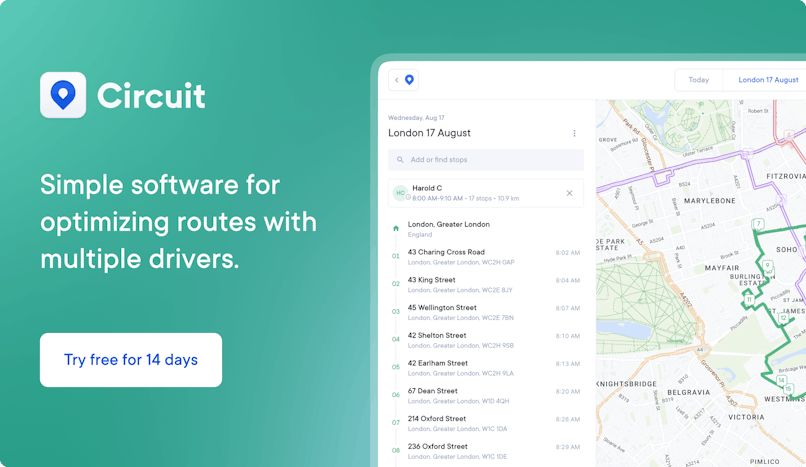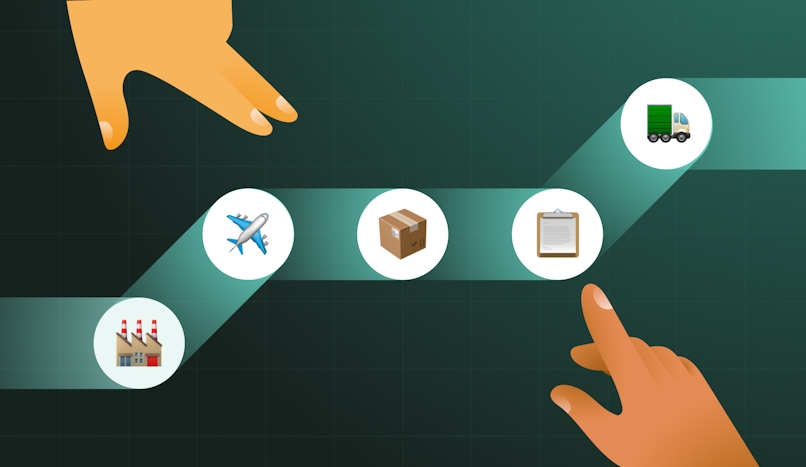What Is a Lean Supply Chain? 8 Benefits
A lean supply chain can save your business time and money and set you apart from the competition. Learn more about lean supply chains here!

Keep your supply chain lean by streamlining last-mile delivery communications and reducing delivery mistakes with Circuit for Teams.
A lean supply chain is like a well-oiled machine that runs smoothly and efficiently.
With lean supply chain management, you can minimize waste and efficiently deliver your products or services without any delays or hiccups. It requires lean thinking: smart decision-making, staying nimble, and continuously making things better for everyone along your supply chain, from your suppliers to your customers.
In this article, I’ll show you how to do these things and how implementing a lean supply chain can positively impact your business. Read on to learn how to lower costs, improve customer satisfaction, and unlock new growth opportunities.
Key takeaways
- Implement lean principles like just-in-time production, kanban systems, continuous improvement, and strong supplier partnerships to effectively reduce waste, minimize excess inventory, and improve operational efficiency.
- Make your operations more cost-effective and efficient by focusing on eliminating activities that don't add value, aligning production with customer demand, and improving logistics processes.
- Make sure your customers get their orders on time by having a consistent supply of products, simplifying your processes, and adopting flexible strategies for producing and delivering goods.
- Minimize waste and boost efficiency by focusing on making the most of your resources, accurately predicting demand, and optimizing your logistics and transportation.

What is an example of a lean supply chain?
Toyota Motor Corporation's vehicle production system is a well-known and often-studied example of a lean supply chain.
Some key components that make Toyota's supply chain lean and efficient include:
- Just-in-time (JIT) production: Toyota uses JIT principles, which involve producing and delivering products in the exact quantities and at the precise time they are needed. This minimizes inventory holding costs and reduces waste associated with excess inventory.
- Kanban system: Toyota uses a kanban system, a visual tool for inventory replenishment (materials are only replenished when necessary to avoid overproduction and reduce inventory levels).
- Continuous improvement (Kaizen): Toyota promotes a culture of continuous improvement, where employees at all levels are encouraged to identify and implement small, incremental changes to optimize processes, enhance quality, and eliminate waste.
- Supplier partnerships: Toyota fosters strong relationships with its suppliers, collaborating closely to improve quality, reduce lead times, and enhance overall supply chain efficiency. This cooperation helps streamline the flow of materials and information.
Implementing these lean principles has helped Toyota achieve remarkable efficiency and cost reductions and deliver high-quality vehicles to automotive customers in a timely manner.

8 benefits of a lean supply chain
A lean supply chain offers several benefits that can significantly impact your business's success.
Below, I’ll give you a better understanding of these benefits and how you can achieve them through a lean and agile supply chain.
1. Cost reduction
A lean supply chain promotes cost savings. You can lower business costs by:
- Eliminating activities that do not add value to the production process, such as unnecessary procurement or movement of goods, excessive inventory, overproduction, and defects
- Closely aligning production with market demand to reduce the need for excessive inventory storage, reducing warehousing costs and the risk of holding obsolete or slow-moving stock
- Improving process efficiency to minimize the sourcing and consumption of resources, such as labor, raw materials, and energy
Significantly reduce production costs and enhance overall operational efficiency by identifying and eliminating waste, streamlining processes, and optimizing resource utilization.
2. Greater customer service
A lean supply chain improves customer service by:
- Streamlining processes and eliminating unnecessary delays to reduce lead times for timely delivery of products to the end customers and to build trust and loyalty
- Adopting just-in-time principles and closely monitoring customer demand patterns, so customers can find the products they need when they need them, leading to increased customer satisfaction and repeat business
- Implementing flexible production and distribution strategies to respond quickly to market trends, introduce new products, or modify existing product offerings based on customer feedback
Focusing on these areas can enhance customer satisfaction, build long-term loyalty, and gain a competitive edge in the market.
3. Reduced waste
A lean supply chain minimizes waste in all forms. You can reduce your business’s waste by:
- Identifying and eliminating activities that don't add value, using automation processes, and aligning production with customer demand to minimize excess inventory and associated risks
- Using resources more effectively and producing high-quality products with limited defects
- Optimizing logistics and transportation to reduce unnecessary movement of goods
Prioritizing waste reduction can boost your business's efficiency, profitability, and environmental sustainability.
4. Increased flexibility & agility
A lean supply chain allows you to respond to market shifts and evolving customer preferences quickly. Increase this flexibility and agility by:
- Identifying and eliminating supply chain bottlenecks, such as inefficient processes or unnecessary delays, for faster production cycles, reduced lead times, and enhanced customer satisfaction
- Implementing efficient processes, such as lean manufacturing processes or agile project management methods, to optimize resource allocation, minimize waste, and improve operational efficiency
- Remaining flexible in operations to adapt to demand fluctuations and make timely adjustments to your production and distribution strategies
Embracing flexibility and agility in the supply chain can help you stay ahead of the competition, seize new opportunities, and effectively meet customers’ evolving needs.
5. Improved quality
A lean supply chain makes quality a core focus. You can improve product and service quality by:
- Prioritizing quality at every step of the production process so customers get products that meet or exceed their expectations
- Standardizing processes and specifications to minimize variability and deliver consistent quality outcomes
- Continuously improving with ongoing enhancements, identifying areas for optimization, and delivering even better products over time
Focusing on defect prevention, standardization, and continuous improvement can enhance product quality, reduce rework and returns, and build a reputation for delivering reliable products.
6. Inventory reduction
A lean supply chain matches production with customer demand. You can reduce your inventory levels as needed by:
- Producing finished goods in response to customer orders to avoid holding costs and reduce the risk of products becoming outdated or obsolete
- Implementing just-in-time principles so components and products arrive precisely when needed, minimizing waste, maximizing efficiency, and optimizing resources
- Using efficient inventory management techniques, such as accurate demand forecasting, strategic supplier partnerships, and real-time inventory tracking
Adopting just-in-time principles and implementing efficient inventory management techniques can reduce your holding costs, minimize the risk of obsolescence, and free up capital for other investments.
7. Better communication
A lean supply chain makes communication a priority. Improve communication by:
- Using clear communication to streamline processes, prevent misunderstandings, and facilitate timely decision-making
- Sharing accurate information with suppliers, logistics partners, and internal teams so everyone is aligned and working toward common goals
- Encouraging collaboration to foster a sense of unity and allow for quick problem-solving, which drives productivity and reduces delays
Establishing clear communication channels, sharing accurate information, and promoting collaboration among supply chain partners can help you enhance coordination, resolve issues more effectively, and improve overall operational efficiency.
8. More profitability
A lean supply chain directly drives profitability. You can increase yours by:
- Implementing cost-saving initiatives, such as eliminating waste and streamlining processes
- Giving exceptional customer service to boost customer satisfaction, loyalty, repeat business, and revenue
- Optimizing the use of resources to maximize efficiency and minimize waste, further improving your bottom line
Reducing costs, enhancing customer service, optimizing resource utilization, and driving operational excellence can help you achieve higher profit margins and strengthen your competitive advantage in the market.

What happens when a supply chain becomes too lean?
While a lean supply chain has many benefits, it is important to strike the right balance and avoid making it excessively lean. Overlooking important elements or oversimplifying processes can impact your supply chain strategy and overall business operations.
Let’s go over some potential drawbacks to consider when trying to maintain a lean supply chain.
Lack of resilience
Supply chains that are too lean can be more vulnerable to disruptions.
Depending on a limited number of suppliers or operating with minimal inventory buffers puts your business at risk of natural disasters, geopolitical issues, or sudden shifts in demand. These disruptions can severely impact your product availability and customer satisfaction.
Take proactive measures to protect your supply chain and make sure you have a reliable and responsive operation. Measures include diversifying your supplier base, maintaining strategic inventory levels, and establishing contingency plans.
Focus on resilience to maintain business continuity, meet customer needs, and minimize the impact of unforeseen events.
Supplier reliability issues
A too-lean supply chain often relies heavily on a limited number of suppliers.
While this approach can result in cost savings and streamlined operations, it also brings the risk of supplier reliability. A key supplier with financial or quality issues or who fails to meet demand can disrupt your entire supply chain.
Maintain a more reliable supply chain by using multiple suppliers and establishing backup plans. This proactive approach limits the potential impact of supplier-related disruptions and safeguards your operations.
Decreased flexibility
An overly lean supply chain may struggle to adapt to unexpected changes or shifts in customer demand.
Responding quickly to market volatility or introducing new products is more challenging when your processes are rigid or optimized only for specific scenarios.
Stay flexible to stay competitive. Embrace adaptable practices that allow you to adjust production, distribution, and strategies as needed. This will also help you stay responsive, seize opportunities, and better navigate uncertainties.
Strained supplier relationships
Considering the impact on your suppliers when implementing lean practices is important.
Strained relationships can happen when demanding excessively low prices or tight delivery schedules without considering your suppliers’ capabilities and constraints. This can compromise long-term collaboration and keep you from realizing the full potential of your supplier partnerships.
Maintain strong supplier relationships by encouraging open communication, fair negotiations, and a cooperative approach that considers your suppliers' needs and capabilities. By working together, you can achieve a successful and sustainable lean supply chain while nurturing valuable supplier partnerships.
Mapping Your Lean Supply Chain
Building a lean supply chain has many business-related benefits, such as saving costs, satisfying customers, reducing waste, boosting flexibility, improving quality, cutting inventory, enhancing communication, and increasing profitability.
Value stream mapping (VSM) is a powerful tool used in Lean Six Sigma that helps you see and understand the entire journey of creating and delivering a product or service to your customers.
Mapping out each step in the process helps you identify areas of waste, inefficiency, and bottlenecks, allowing you to make targeted improvements and enhance productivity. With the right map, your lean supply chain will propel your business forward and unlock its full potential.
Deliver products exactly when your customers need them with Circuit for Teams
Get your products delivered to customers just in time with Circuit for Teams. This dispatcher-friendly tool considers all the factors that can affect your deliveries, creating the most efficient routes for timely service.
It gives you the flexibility to customize each stop along a route, adding specific details to accommodate every delivery’s unique requirements. You can also make real-time route edits for smooth adjustments and improve communication with your drivers.
Plus, stay connected with customers through real-time ETA and delivery updates to keep them in the loop along the way. Try Circuit for Teams for free today!




